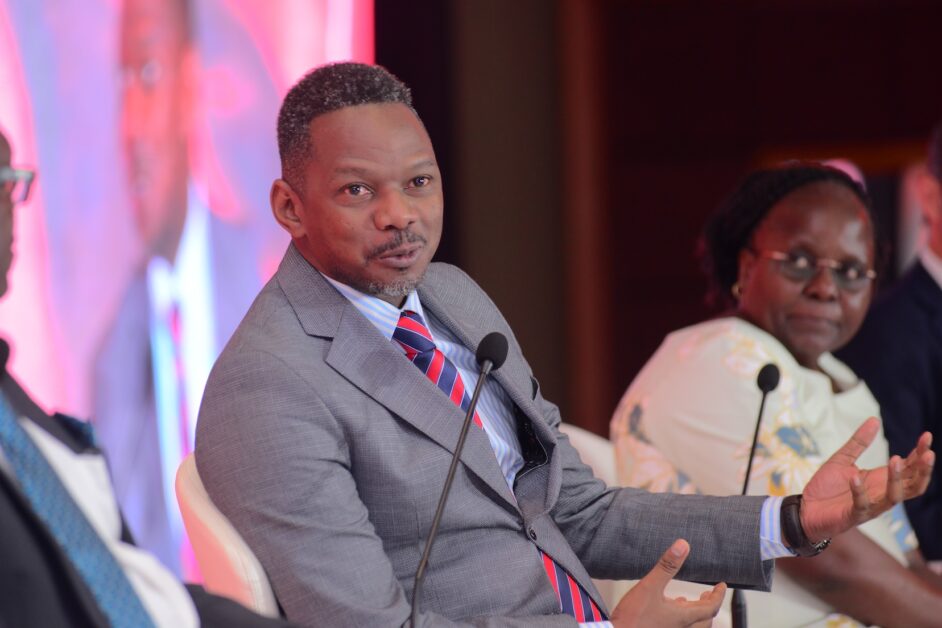The government of Uganda’s continued uncontrolled borrowing from commercial banks via government securities and at anti-market rates to the detriment of the private sector dominated the greater part of the just-ended Absa 2024 Economic Outlook Forum.
Various experts called out the government for failing to tame its growing appetite for borrowing from the local markets and at double-digit rates, something that is increasingly making it unattractive to lend to local businesses especially SMEs and startups on one hand while also killing venture capital options as the pension funds, whose long term funds would be a reliable source of very affordable venture and equity capital have also happily joined the government securities gravy train.
“Why should a government issue a 10, 15, 20-year bond at 14-15%? Who in his right mind is going to lend money or go into a venture capital, when they can actually buy a government bond and be comfortable? Which pension fund manager is going to risk the wrath of his members and do that?,” Patrick Ayota, the Managing Director of the National Social Security Fund (NSSF) said, when asked why NSSF was not funding startups.
“So structurally, what is it in our government; in the way we govern ourselves, that we can lend an interest risk-free instrument at 16%? Until we are willing to put that on the table, all the other things about the cost of capital are a mirage. There is no way a bank is going to lend at 10% when they can buy a Uganda government bond and get 16%,” Ayota reiterated.
And Ayota is putting his money where his mouth is.

NSSF at the end of the FY2022/23 had UGX14.34 trillion invested into government securities, not only in Uganda but in other governments in the East African region. That is just about 78.48% of the Fund’s total investment.
NSSF’s government securities holding reflects that of the general holdings of the pension s sector. As of June 2023 up to 78.1% of the entire sector’s investment portfolio, equivalent to UGX16.7 trillion was held in government securities and only 11.7% (UGX2.6 trillion) in equities. Most of the equity investments⏤ UGX2.2 trillion were held in listed equities and only UGX347 billion in unlisted equities.
The pension sector’ holding of government securities is rivalled by that of commercial banks. Between 2022 and 2017, commercial bank holdings of government securities grew by 141% from UGX5.6 trillion to UGX13.4 trillion.
On the other hand, total lending to the private sector in the same period grew by 56% from UGX11.7 trillion to UGX18.2 trillion. But while total commercial bank lending is some UGX4.8 trillion higher than what the commercial banks have invested in government securities, it is important to note that commercial banks’ government securities portfolio is growing faster- at a compounded annual growth rate of 15.8% compared to commercial banks’ private sector credit which is growing at a CAGR of 7.7%. Simply put, commercial banks’ government securities appetite is growing twice as fast as private sector lending⏤ banks would rather lend to the government than to their depositors.
Jeff Gable, the Head of Macro and Fixed Income Research at Absa Group, attributes this low private sector credit creation to elevated government borrowing appetite.
“The government’s absorbing so much money,” he said, and at “really juicy interest rates”.
According to Jeff Gable, it is not the banks to blame, but rather taming the government’s appetite for market borrowing is the solution to lowering interest rates and freeing up the much-needed credit for the private sector.
“It’s not so much that the banks are mean, but everyone’s competing for capital and often the government gets its share first,” he says, adding: “How do you bring that interest rate down? You bring that interest rate down by either needing less of it (less borrowing), or you bring that interest rate down by having more savings”.
“Encouraging larger local pools of capital to help bring interest rates down, having a government that has tighter financing needs, both of those things leave more money available to the private sector at rates that are probably more suitable,” he adds.
Really juicy government interest rates
Over the last 5 years, Uganda’s total public debt has grown by 111.7% from UGX46 trillion in 2018/19 to UGX97.5 trillion as of 30th June 2023. Of the UGX97.5 trillion, UGX44.7 trillion was domestic debt and UGX52.8 trillion external debt. Of the UGX52.9 trillion external debt, UGX7.1 trillion was borrowed from commercial banks. This is 36% of total commercial bank private sector credit as of 30th June 2023 (UGX19.6 trillion).
For example, the government in Q4 of FY2022/23 borrowed €500 million (UGX2 trillion) from Stanbic Bank Uganda and its parent, Standard Bank South Africa, to plug holes in its FY 2022/23 budget.CEO East Africa Magazine can exclusively reveal.
The country’s domestic debt stock, mainly treasury bonds and treasury bills, as well as unsecuritised debt, amounted to UGX33.3 trillion⏤ a reduction of UGX2.8 trillion from UGX36.1 trillion the previous year.
But the government is also not only starving the private sector of credit, it is also not paying its debts on time. The government’s domestic arrears increased from UGX8.059 trillion in 2022 to UGX.10.82 trillion in 2023 constituting a 34.4% increase.
According to the Auditor General, “the growth trend appears unsustainable and on the rise”.
Tight credit market and historic low credit growth rates
According to the Bank of Uganda State of the Economy December 2023 report, although the primary market yields for the 2-year, 3-year, 5-year, 10-year,15-year, and 20-year declined across the three months to November 2023, the decline was marginal and still juicy enough for commercial banks and anybody else looking for a gravy train. The Treasury bond yields for the 2-year, 3-year, 5-year, 10-year,15-year, and 20-year averaged 13%, 13.6%, 14.7%, 15.1%, 15.8%, and 15.5% in the three months to November 2023 from 13.5%, 13.7%, 14.8%, 15.2%, 16%, and 16.0% in the three months to August 2023, respectively.

However, the Treasury bill yields for the 182-day and 364-day increased, averaging 12.4% and 12.9% respectively in the three months to November 2023 compared to 11.4% and 12.3%, in the three months to August 2023.
It is therefore not surprising that during this period, commercial banks’ lending rates, “remained elevated due to the tight funding conditions of commercial banks and high credit risk”.
The average shilling lending rate was 18.8% in the three months to October 2023, while the average lending rate for foreign currency-denominated loans was 9.0% over the same period. Prime lending rates stood at 20.6%.
“Although the growth in total credit to the private sector, which includes FX loans rose to 7.8% in the three months to October 2023, up from 7.3% in the three months to July 2023, it is still below the historical average”, the Central Bank reported in its December 2023 State of the Economy report.
“Growth in shilling-denominated loans decreased to 9.6% in the three months to October 2023 from 11.4% observed in the three months to July 2023, while foreign currency-denominated loans’ growth grew by 3.3% from a contraction of 2.1% over the same period. The approval rate for credit in value terms decreased in the three months to October 2023 to 58.6% from 64.1% in the three months to July 2023,” the central bank added.
Urgent pension sector reforms needed
Alan Lwetabe is a Uganda-based macroeconomist and investment professional. He is one of the few Chartered Financial Analysts (CFA) in Uganda. He is also the Head of Investments at the Deposit Protection Fund of Uganda (DPF), a government agency that provides deposit insurance to customers of deposit-taking institutions licensed by the Bank of Uganda.
Prior to that, he spent nearly 13 years at the Bank of Uganda where he rose to the Assistant Director role in Charge of Foreign Reserves Management.
Outside of his official roles in government, Alan has deep interests in nurturing start-up ventures and helping them grow domestic private markets by connecting compelling entrepreneurs with local institutional investors. He is one of the co-founders of the Founder Institute Kampala and is working under a VC Lab to launch a pre-seed venture fund to back Kampala Startups.
He is also a member of the CFA Society East Africa, a regional association of investment professionals from Kenya, Uganda, Tanzania and Rwanda.
Although his employer, the DPF at the end of FY2021/22 held UGX1.15 trillion in government securities (98 per cent), up from UGX1,128 billion the previous year, thanks to a risk-averse investment policy that emphasises “preservation of capital and availability of liquidity”, Alan is deeply aware of the need to sweat these monies more.
He believes there is a need to aggressively revisit the conservative investment policies of most pension funds, as well as address the acute risk-averseness that is prevalent in the industry.
“We have attitudes that are negative towards the growth of markets. I’ve sat with many pension trustees and you would ask them, why don’t you consider venture capital for example, and they will say can we get a guarantee? I would then say this is venture capital, you should be able to appraise the risk and make a decision ⏤but they are looking for a guarantee in a highly illiquid market. This creates a challenge for us. It’s not just how much savings we are putting together, but are the people who are putting together these savings are able to take decisions, take risks?” he told stakeholders at the 2024 Absa Economic Outlook Forum.
He says that the CFA Society East Africa has started engaging and educating pension trustees, about their roles as fiduciaries on one hand, but also “giving them the tools and techniques that can allow them to release and allocate more funds to other spaces away from government bonds”.

“It’s important that investments are democratised. It’s important that we diversify. 90% of our savings are in government bonds,” he emphasises.
Dr. Michael Atingi-Ego, the Bank of Uganda Deputy Governor, speaking at the same forum also highlighted the pension sector’s failure to redirect their investments to the real sector and called for a “need for further pension sector reforms to ensure that pension assets are invested in the real sector of the domestic economic growth”.
And these reforms are not just nice to have- it is a matter of survival, especially for the pension funds such as NSSF. Redirecting savings to the more producing real sector where more jobs can be created and savings generated, is a matter of life and death.
“In an economy that’s not generating enough jobs, it means⏤ we did an extrapolation, that if we did nothing as NSSF and we do not generate enough members, hence enough jobs, in 22 years we will die. So it is to our own benefit to create members now by creating jobs,” Ayota says.
This is the motivation behind NSSF being heavily involved in the Hi-Innovator programme. Launched in May 2021, the Hi-Innovator is an initiative aimed at supporting youth and small and medium-sized businesses to sustainably grow through entrepreneurship education, funding, and technical support. It is being implemented together with the MasterCard Foundation under the Young Africa Works initiative and Outbox Uganda.
“NSSF as an entity, grows in only two ways. Organically if our revenues are more than our expenses we will grow. The other way we grow is when we get new contributions, which means we have new members coming in,” Ayota adds.
According to the Absa AFMIndex, although according to the 2023 Absa Africa Financial Market Index, Uganda with an overall score of 62.8, maintained its fourth position out of 28 African countries, Uganda’s score declined from 64.4 the year before.The decrease was mostly driven by weaker performance in Pillar 2⏤Access to Foreign Exchange and Pillar 4 – Capacity of local investors. Particularly, Uganda’s score was affected by the decline in pension assets per capita from USD125 in 2022 to USD119 in 2023, more than 7 times lower than the average USD847 and Kenya’s USD251.
